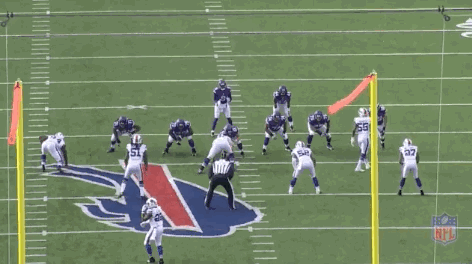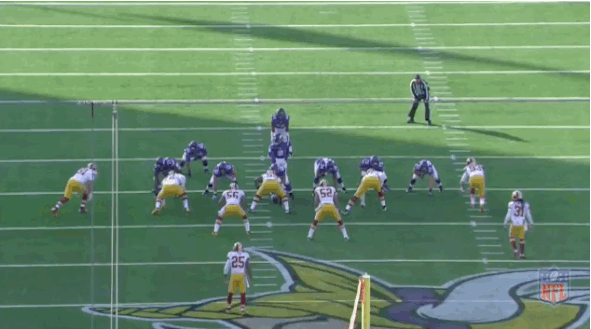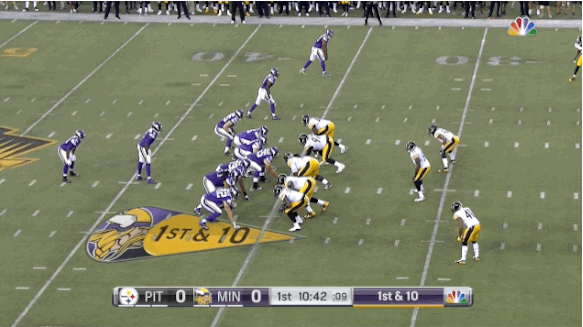Teddy Bridgewater is Not a Running Quarterback

Behind a leaky offensive line and without star running back Adrian Peterson, Teddy Bridgewater found himself in quite a few uncomfortable situations last season. According to ESPN Stats and Info, the rookie quarterback was sacked 39 times, hit another 14, and was pressured on 29.9 percent of his 469 dropbacks in 2014.
In an effort to improve his durability, the team set a 215-pound weight limit for the 6’3″ Bridgewater this offseason, and the quarterback believes the added weight will help him “withstand some hits” he’s “going to take throughout the year,” per ESPN’s Ben Goessling. The muscle, along with a slightly retooled, improved offensive line, are all preventative measures to ensure the longevity and sustained success of the franchise’s most important player.
If I were to step into Rick Spielman’s shoes for a day, though, I’d enact one more policy to protect Teddy Bridgewater’s health:
Don’t Let Teddy Run the Read-Option
On Wednesday, Sports Illustrated’s Andy Benoit took to Twitter to share film notes from the Vikings’ 2014 season. He expanded on the potential of Anthony Barr and Sharrif Floyd, pondered Adrian Peterson’s fit in Norv Turner’s inside running attack, and even suggested that Teddy Bridgewater could run the read-option this season:
#Vikings Notes: Bridgewater better feet than people realize. Will read-option become a regular run game element?
— Andy Benoit (@Andy_Benoit) August 12, 2015
While I don’t disagree that Bridgewater is capable of running the read-option, I don’t think it’s in Norv Turner’s best interest to subject his quarterback to that kind of punishment. The read-option is successful because it puts defensive ends and outside linebackers (edge defenders) in almost impossible situations at times. But, it also makes quarterbacks pseudo-running backs, exposing them to hits they wouldn’t normally take in the pocket. Over at Bleacher Report, Matt Bowen explained the concept beautifully:
[quote_box_center]With zone blocking up front, the quarterback can give the ball to the running back (dive) or keep (pull) based on his “read” of the unblocked edge defender.
If the edge defender crashes on the dive, the quarterback will pull the ball and press to the outside. If the edge defender stays up the field or “slow plays” the mesh point (lateral shuffle to play both dive and keep), the quarterback can hand the ball to the back.[/quote_box_center]
Last year, Turner first experimented with the read-option in Week 4, which was also Bridgewater’s first start of the season. Without Adrian Peterson, Turner needed to find ways to make the running game “go,” and worked the option to take advantage of Jerick McKinnon’s athleticism. “A couple of them were read options with Teddy,” McKinnon said in an interview with ESPN’s Andrew Krammer following the game. “Some of them he gave, and he kept one. It was good for us today.”
Short-term? It keeps defenses “honest” and creates positive matchups for offenses. By incorporating the quarterback into the running game, defenses are forced to commit an extra defender in the box or on the edge, and teams often design passing plays or play action concepts to exploit holes created by those adjustments. Norv Turner and the Vikings offense showed a few of these concepts last year, but never made them a staple of the offense.
Long-term? Defenses find ways to take away both options, neutralizing the threat of a quarterback keep or a quarterback give. Edge defenders are often taught to hit the quarterback on EVERY read-option play — see Colin Kaepernick —and defensive coordinators are coming up with new ways to prevent big gains or eliminate the play completely.
In the image below, from the Vikings’ Week 6 matchup with the Buffalo Bills, Bridgewater and Matt Asiata mesh perfectly to fool the crashing edge defender (and the camera man!). Bridgewater sees the action, pulling the ball and picking up a few yards before diving headfirst and avoiding unnecessary contact. It’s a positive play, but the potential for disaster is there.
Watch the No. 52 linebacker — he gets sucked inside, but rallies quickly to the scampering Bridgewater. If Bridgewater doesn’t slide, dive, or protect himself, he’s at risk of receiving a blind-side hit and getting knocked out of the game. This play came just two weeks after Bridgewater sprained his ankle running the football against the Falcons, and could have led to another injury had Bridgewater made the wrong read or been hit from the side.
As I mentioned above, defensive coordinators are formulating new defensive concepts to stop these plays before they can even begin. Utilizing the “Scrape Exchange” technique, No. 52 would have spied Bridgewater and scraped over the top to hit him in the backfield. The defensive end in the situation would be primarily responsible for the running back, negating any sort of read from the two defenders. Unless the Vikings hope to roll out a number of packaged plays designed around the read-option, it’ll be much harder to be consistently successful running this concept.
And of course, we can’t forget about Adrian Peterson. He returns to the backfield in 2015 and will demand a majority of the team’s touches, many of which will not be through the read-option.
Teddy CAN run
Bridgewater is fully capable of running the read-option. He’s athletic, has quick feet, and an advanced understanding of the game. He mastered the playbook at Louisville, per NFL.com’s Bucky Brooks, and would have no problem learning the inner workings of the read-option.
But, Teddy Bridgewater is not a running quarterback.
Yes, he rushed 47 times for 209 yards and a touchdown last year, but that was more a testament to Bridgewater’s patience and pocket presence than his desire to run. When Bridgewater runs, it’s not predetermined or out of panic. Take this example from Week 8 against the Washington Redskins in 2014:
After completing the play action fake, Bridgewater sets his feet and appears to start going through his route progression. In a scene more common than not in 2014, however, the protection breaks down and Bridgewater is forced to tuck the ball and run. He not only finds and open running lane, but gets out of bounds after picking up a first down. Instead of wilting and taking the sack, as many rookies would have done, Bridgewater displays his trademark calmness in the pocket and makes a veteran play for his team.
After the game, head coach Mike Zimmer commented on Bridgewater’s opportunistic running. “I talked to him one time during the game about using his legs a little bit; if he’s got it, take it,” he said in an interview with Brian Hall. “And he started doing that, which allowed other things to open up for people.”
When he was drafted, coaches understood Bridgewater was not necessarily the draft’s best running quarterback, but knew with certainty that he was the draft’s best pocket passer. Before the draft, Bucky Brooks wrote this at NFL.com: “Most offensive coordinators in the pro game would opt for a polished pocket passer over a dynamic run-first quarterback.”
The Vikings got just that — a quarterback who thrives with excellent footwork inside the pocket and succeeds by using that footwork to escape the rush. “He is nimble and elusive within a short area, and has enough speed to flee the pocket when it collapses for a positive gain,” Brooks wrote, and those words are being played out every Sunday by Bridgewater. He’ll never beat Robert Griffen III or Russell Wilson in the 40-yard dash, but Bridgewater’s athleticism is enough to extend drives, prevent sacks, and keep the Vikings’ offense on the field. Why risk injury and losing that to run the read-option?
Let the kid throw
Bridgewater is as pure a passer as you’ll find among the league’s young quarterbacks, but Norv Turner doesn’t necessarily keep him tied to the pocket. It was almost impossible last year with a makeshift offensive line, but Bridgewater can thrive throwing in confined spaces or on the run.
Looking back at Week 15 of last year, against the Detroit Lions’ top-ranked defense, Norv Turner put the pieces in place for future success while making the most of Bridgewater’s athleticism. According to Andrew Krammer’s film breakdown on ESPN 1500, Turner mixed up “looks with play-action bootlegs, halfback and tight end screens, as well as moving pockets” to negate the Lions’ ferocious pass rush.
The strategies not only allowed Bridgewater to get rid of the ball quickly, but move away from the rush before completing short passes to his receivers, tight ends, and running backs. Save for two costly interceptions, Bridgewater finished the game 31-of-41 for 315 yards and a touchdown.
Last Sunday, in the Hall of Fame Game, we saw Norv Turner apply a few more of those concepts during Teddy’s lone drive. Bridgewater completed short passes underneath to Kyle Rudolph and Jarius Wright, and even hit Jerick McKinnon and Charles Johnson on quick-hitting screen passes. Late in the drive, Bridgewater faked a run to the left and “waggled” right as part of a play action rollout. Mike Wallace came open underneath, but Bridgewater hit him late and left the throw at Wallace’s feet. The potential for a big play was there, but it’s early — they’ll connect later on.
Aside from the quick passes and short attack, one of my favorite plays came midway through the drive, when Teddy showed off his pocket presence and field awareness. Bridgewater faked the handoff to McKinnon, set his feet at the top of his drop, and moved up in the pocket with excellent footwork. The rush wasn’t threatening, but Bridgewater’s first reads were covered. As he did against the Redskins last year, Bridgewater tucked the ball and picked up six yards. And, he slid well before the ensuing defenders could make contact.
Sure, the idea of Teddy Bridgewater and Adrian Peterson running the read-option is sexy. While, I’d love to see it, I’m content watching a healthy Teddy Bridgewater do what he does best — throw the football. He’ll run the ball only if he has to or sees an opportunity to do so, but Bridgewater’s always going to be a passer first, and I’m happy to see the Vikings win games with a healthy Bridgewater under center.




You must be logged in to post a comment.